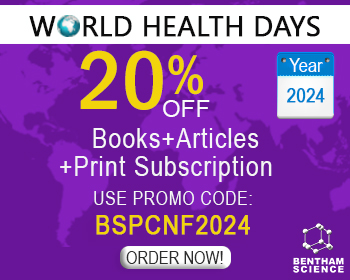Abstract
Introduction: Aging is characterized as a syndrome of deleterious, progressive, universal, and irreversible function changes affecting every structural and functional aspect of the organism and accompanied by a generalized increase in mortality. Although a substantial number of candidates for biomarkers of aging have been proposed, none has been validated or universally accepted. Human telomeres constitute hexameric repetitive DNA sequence nucleoprotein complexes that cap chromosome ends, regulating gene expression and modulating stress-related pathways. Telomere length (TL) shortening is observed both in cellular senescence and advanced age, leading to the investigation of TL as a biomarker for aging and a risk factor indicator for the development and progression of the most common age-related diseases.
Objective: The present review underlines the connection between TL and the pathophysiology of the diseases associated with telomere attrition.
Methods: We performed a structured search of the PubMed database for peer-reviewed research of the literature regarding leukocyte TL and cardiovascular diseases (CVD), more specifically stroke and heart disease, and focused on the relevant articles published during the last 5 years. We also applied Hill’s criteria of causation to strengthen this association.
Results: We analyzed the recent literature regarding TL length, stroke, and CVD. Although approximately one-third of the available studies support the connection, the results of different studies seem to be rather conflicting as a result of different study designs, divergent methods of TL determination, small study samples, and patient population heterogeneity. After applying Hill’s criteria, we can observe that the literature conforms to them weakly, with chronology being the only Hill criterion of causality that probably cannot be contested.
Conclusion: The present review attempted to examine the purported relation between leukocyte TL and age-related diseases such as CVD and more specific stroke and heart disease in view of the best established, comprehensive, medical and epidemiological criteria that have characterized the focused recent relevant research. Although several recommendations have been made that may contribute significantly to the field, a call for novel technical approaches and studies is mandatory to further elucidate the possible association.
Keywords: Telomere length, cardiovascular disease, stroke, heart disease, Hill’s criteria, Alzheimer's disease.
[http://dx.doi.org/10.1126/science.132.3418.14] [PMID: 13835176]
[http://dx.doi.org/10.1126/science.aab3389] [PMID: 26785477]
[http://dx.doi.org/10.3389/fimmu.2017.01078] [PMID: 28928745]
[http://dx.doi.org/10.1007/s10522-018-9769-1] [PMID: 30229407]
[http://dx.doi.org/10.2174/1566524053586545] [PMID: 15974873]
[http://dx.doi.org/10.1016/j.jacc.2016.03.541] [PMID: 27230042]
[http://dx.doi.org/10.1161/HYPERTENSIONAHA.117.09454] [PMID: 28630208]
[http://dx.doi.org/10.1016/j.jacc.2018.06.014] [PMID: 30092957]
[http://dx.doi.org/10.1038/ng.2528]
[http://dx.doi.org/10.1373/clinchem.2016.258566] [PMID: 27259814]
[http://dx.doi.org/10.1111/j.1474-9726.2007.00321.x] [PMID: 17874998]
[http://dx.doi.org/10.1093/eurheartj/ehp324] [PMID: 19687155]
[http://dx.doi.org/10.1161/HYPERTENSIONAHA.117.09354] [PMID: 28630210]
[http://dx.doi.org/10.1016/j.jacc.2018.06.014]
[http://dx.doi.org/10.1146/annurev.genet.41.110306.130350] [PMID: 18680434]
[http://dx.doi.org/10.1111/j.1532-5415.2005.53492.x] [PMID: 16131355]
[http://dx.doi.org/10.1016/j.febslet.2004.11.036] [PMID: 15680963]
[http://dx.doi.org/10.1073/pnas.0913125107] [PMID: 20479226]
[http://dx.doi.org/10.1016/j.neurobiolaging.2015.06.017] [PMID: 26239175]
[http://dx.doi.org/10.1038/srep32280] [PMID: 27578458]
[http://dx.doi.org/10.1016/j.cell.2018.04.038] [PMID: 29775593]
[http://dx.doi.org/10.1016/j.bios.2018.09.049] [PMID: 30240966]
[http://dx.doi.org/10.1016/j.ejmech.2017.12.077] [PMID: 29335203]
[http://dx.doi.org/10.1038/nrc3025] [PMID: 21346783]
[http://dx.doi.org/10.1177/003591576505800503] [PMID: 14283879]
[http://dx.doi.org/10.1016/0014-4827(61)90192-6] [PMID: 13905658]
[http://dx.doi.org/10.1038/345458a0] [PMID: 2342578]
[http://dx.doi.org/10.1016/0022-5193(73)90198-7] [PMID: 4754905]
[http://dx.doi.org/10.1093/geronj/23.1.71]
[http://dx.doi.org/10.3390/ijms18081765] [PMID: 28805708]
[http://dx.doi.org/10.1098/rstb.2016.0451] [PMID: 29335378]
[http://dx.doi.org/10.1093/ije/dyu191] [PMID: 25239152]
[http://dx.doi.org/10.1371/journal.pone.0113747] [PMID: 25409313]
[http://dx.doi.org/10.1016/j.ymeth.2016.08.008] [PMID: 27565742]
[http://dx.doi.org/10.3389/fnagi.2017.00397] [PMID: 29270121]
[http://dx.doi.org/10.1016/j.semcancer.2012.02.001] [PMID: 22330096]
[http://dx.doi.org/10.1038/s41467-017-01291-z] [PMID: 29116081]
[http://dx.doi.org/10.4155/fsoa-2017-0115]
[PMID: 7977349]
[http://dx.doi.org/10.1161/01.HYP.36.2.195] [PMID: 10948077]
[http://dx.doi.org/10.1016/S0140-6736(15)01225-8] [PMID: 26724178]
[http://dx.doi.org/10.1097/HJH.0000000000000881] [PMID: 26848994]
[http://dx.doi.org/10.1016/S0140-6736(15)00805-3] [PMID: 26559744]
[http://dx.doi.org/10.1038/jhh.2016.45] [PMID: 27357526]
[http://dx.doi.org/10.1210/jc.2011-1562] [PMID: 22319045]
[http://dx.doi.org/10.1161/01.CIR.0000163550.70487.0B] [PMID: 15851602]
[http://dx.doi.org/10.1016/j.trsl.2009.09.012] [PMID: 20303464]
[http://dx.doi.org/10.1161/STROKEAHA.115.011837] [PMID: 26786116]
[http://dx.doi.org/10.1253/circj.CJ-18-0880] [PMID: 31118363]
[http://dx.doi.org/10.18632/aging.100671] [PMID: 24902894]
[http://dx.doi.org/10.1136/bmj.g4227] [PMID: 25006006]
[http://dx.doi.org/10.1016/S0140-6736(01)05633-1] [PMID: 11513915]
[http://dx.doi.org/10.1161/01.ATV.0000067426.96344.32] [PMID: 12649083]
[http://dx.doi.org/10.2527/1992.70113281x] [PMID: 1459888]
[http://dx.doi.org/10.1111/ggi.12772] [PMID: 27018281]
[http://dx.doi.org/10.1038/s41598-018-35122-y] [PMID: 30413768]
[http://dx.doi.org/10.1002/ajhb.22906] [PMID: 27562613]
[http://dx.doi.org/10.1016/j.jand.2018.09.007] [PMID: 30563782]
[http://dx.doi.org/10.1371/journal.pone.0204704] [PMID: 30261026]
[http://dx.doi.org/10.1016/j.exger.2018.02.030] [PMID: 29518479]
[http://dx.doi.org/10.1007/s11357-020-00291-0] [PMID: 33190211]
[http://dx.doi.org/10.3389/fpsyt.2020.00100]
[http://dx.doi.org/10.18632/aging.102173] [PMID: 31422385]
[http://dx.doi.org/10.3389/fneur.2019.00624]
[http://dx.doi.org/10.1038/s41598-021-90435-9] [PMID: 34040069]
[http://dx.doi.org/10.1161/STROKEAHA.111.637207] [PMID: 22343648]
[http://dx.doi.org/10.1097/MD.0000000000014593] [PMID: 30762812]
[http://dx.doi.org/10.1186/s12967-020-02551-1]
[http://dx.doi.org/10.1097/MD.0000000000012489] [PMID: 30278538]
[http://dx.doi.org/10.3390/cells8020159] [PMID: 30769869]
[http://dx.doi.org/10.1586/ehm.13.23] [PMID: 23782086]
[http://dx.doi.org/10.1038/ng1346] [PMID: 15098033]
[http://dx.doi.org/10.1097/HCO.0000000000000613] [PMID: 30747731]
[http://dx.doi.org/10.3390/genes7090058] [PMID: 27598203]
[http://dx.doi.org/10.3389/fgene.2020.630186] [PMID: 33552142]
[http://dx.doi.org/10.1111/acel.12859] [PMID: 30488553]
[http://dx.doi.org/10.1371/journal.pmed.0020124]
[http://dx.doi.org/10.1038/515009a]
[http://dx.doi.org/10.1093/gerona/gly184] [PMID: 30137208]
[http://dx.doi.org/10.1080/10408363.2018.1504274] [PMID: 30265166]
[http://dx.doi.org/10.1007/s11033-020-05551-y] [PMID: 32876842]
[http://dx.doi.org/10.3390/cancers12030558] [PMID: 32121056]
[http://dx.doi.org/10.1042/BSR20192306] [PMID: 31647542]
[http://dx.doi.org/10.1038/s41598-018-20434-w]
[http://dx.doi.org/10.1016/j.mrrev.2020.108309] [PMID: 32430098]
[http://dx.doi.org/10.1016/j.arr.2019.01.004] [PMID: 30615937]


























